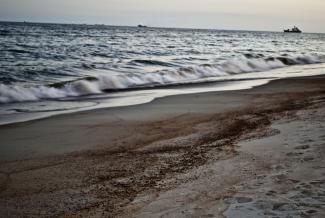On October 2, approximately 25,000 gallons of oil spilled into the Pacific Ocean from a pipeline off the shore of Huntington Beach in Orange County, California. While the full environmental impact of the spill is still under investigation, it is clear that the oil spill threatens the money, time, and effort that have gone into rehabilitating and maintaining nearby wetlands. Dead fish and birds were seen washing up on shore. Oil now coats the rocky beach. The coastal wetlands near the spill that took years of funding and organizing to build will experience acute and chronic effects for years to come.
Oils spills are well-documented to negatively impact wetlands. After the Deepwater Horizon oil spill in 2010, the Congressional Research Service released a report that details a variety of long- and short-term ecological effects of oil spills on coastal wetlands. Damages can include the destabilization of shoreline soil, death of vegetation, and fatalities of marine animals and birds. The report emphasizes that while negative impacts can be expected, the extent of the damage is often uncertain in the short term. Factors such as weather, type of oil, local ecology, time of year, ocean currents, and pace of cleanup all play a role in determining the severity of the ecological impacts from this oil spill. In these early stages of cleanup and investigations in California, the extent of ecological damage is uncertain. What is certain is that benefits gained over decades of local efforts to revitalize the area’s wetlands are now in peril.

Huntington Beach is adjacent to four coastal wetlands totaling over 141 acres that have received years of rehabilitation from both local and state organizations. The Huntington Beach Wetlands Conservancy (HBWC) began working in the 1980s and now receives about $300,000 in grants and donations each year. Since the start of its restoration, around 90 species of birds have been observed at the 25-acre Talbert Marsh. Efforts to restore Brookhurst Marsh to its historical marsh channels and full tidal influence were completed in 2020. The California Coastal Conservancy emphasized that a recent $2 million plus grant was a “culmination of more than 30 years of efforts by the HBWC in partnership with the Conservancy to secure the Huntington Beach Wetlands, restore the marshes, and provide public access and interpretation.” Local expertise and connections must be built over decades to facilitate the kind of success experienced by the Huntington Beach wetland system.
It is important not to forget the less tangible costs of the oil spill. Huntington Beach’s coastal wetlands serve as opportunities for community engagement. HBWC, the Wetlands Wildlife and Care Center, and Bolsa Chica Conservancy are all small nonprofit organizations that rely on volunteers to run their conservation operations while offering opportunities for people to work outdoors. Bolsa Chica runs a program to help people complete court-mandated community service. In 2014, the Huntington Beach Wetland Conservancy opened an interactive learning center that caters to volunteers and local school groups. These organizations create opportunities for people to learn that restoration efforts are both important and deeply rewarding for the community.
Orange County Supervisor Katrina Foley articulated the scope of the work put into these wetlands in an interview with CNN, explaining that the county has been working with the U.S. Army Corps of Engineers, a local land trust, and a number of community wildlife partners for decades to create a beautiful, natural habitat. “And now in just a day, it’s completely destroyed,” she lamented. The oil spill threw hard-earned benefits of the Huntington Beach wetland restoration into flux. Years of grant writing, nurturing vegetation, wetland construction, and program-building will, at best, suffer significant setbacks and serious damage and, at worst, complete loss.
Although California has not issued any new leases for offshore drilling in state waters for more than 50 years, there are still 151 active oil rigs off the coast of Huntington Beach. Renewed advocacy seeks to ban offshore oil drilling completely. On October 19, 2021, the Huntington Beach City Council voted to ban new offshore drilling off its coastline. Sen. Diane Feinstein and Rep. Jared Huffman have commented on the urgency of passing the West Coast Ocean Protection Act, which they introduced earlier this year. Pushing the problem down the road is no longer an option.
Even in the short time the oil was actively spilling off the shore of Huntington Beach, the lost resources across only a few hundred acres of land will likely prove to be significant. Despite the devastating impacts, local organizations push on. People understand the value that wetlands add to the community and that the years of effort put into restoring and maintaining them are worth it. But if oil spills continue to happen again and again, will there be a point when they decide such efforts are no longer worth it?
